Engine JAGUAR XFR 2010 1.G Workshop Manual
[x] Cancel search | Manufacturer: JAGUAR, Model Year: 2010, Model line: XFR, Model: JAGUAR XFR 2010 1.GPages: 3039, PDF Size: 58.49 MB
Page 729 of 3039
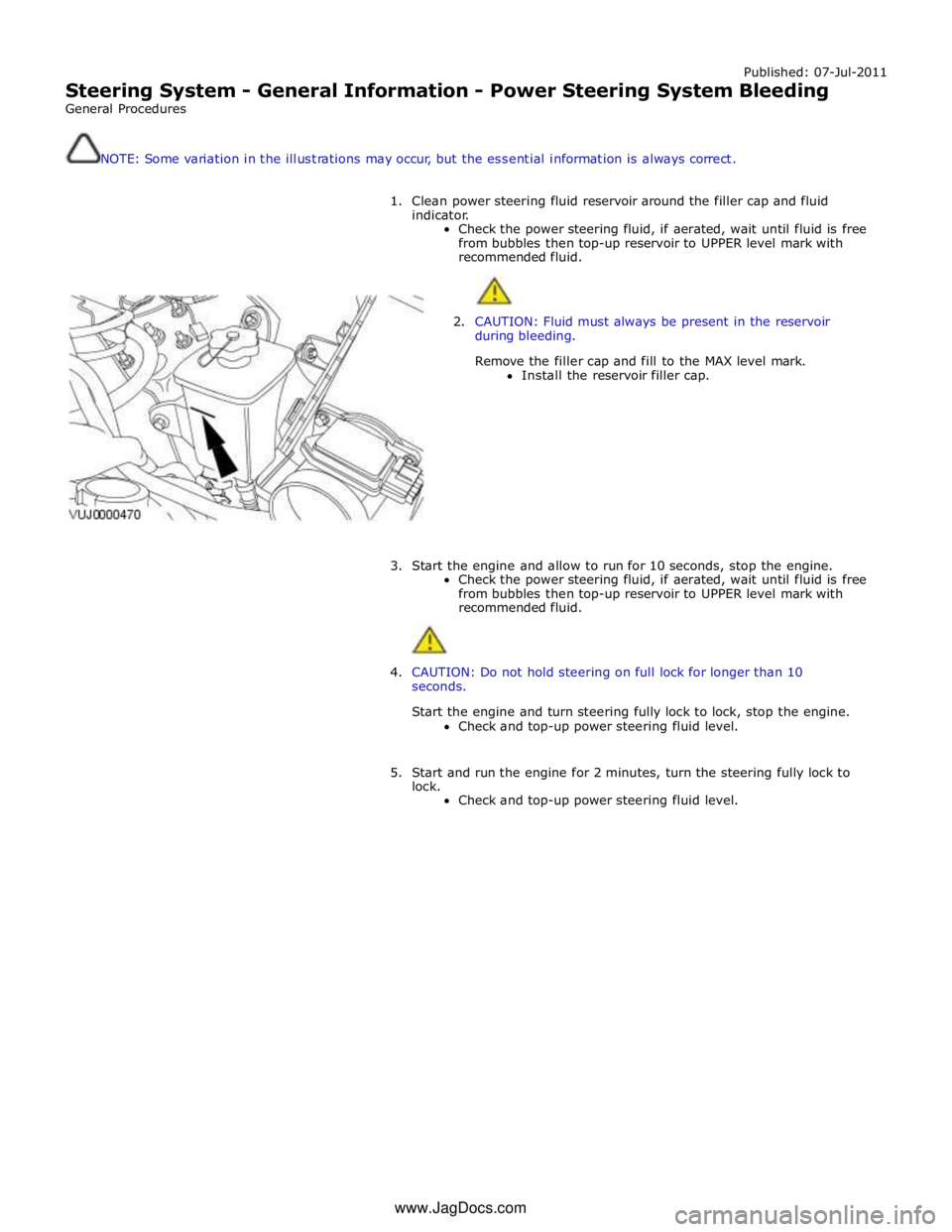
Published: 07-Jul-2011
Steering System - General Information - Power Steering System Bleeding
General Procedures
NOTE: Some variation in the illustrations may occur, but the essential information is always correct.
1. Clean power steering fluid reservoir around the filler cap and fluid
indicator.
Check the power steering fluid, if aerated, wait until fluid is free
from bubbles then top-up reservoir to UPPER level mark with
recommended fluid.
2. CAUTION: Fluid must always be present in the reservoir
during bleeding.
Remove the filler cap and fill to the MAX level mark.
Install the reservoir filler cap.
3. Start the engine and allow to run for 10 seconds, stop the engine.
Check the power steering fluid, if aerated, wait until fluid is free
from bubbles then top-up reservoir to UPPER level mark with
recommended fluid.
4. CAUTION: Do not hold steering on full lock for longer than 10
seconds.
Start the engine and turn steering fully lock to lock, stop the engine.
Check and top-up power steering fluid level.
5. Start and run the engine for 2 minutes, turn the steering fully lock to
lock.
Check and top-up power steering fluid level. www.JagDocs.com
Page 732 of 3039
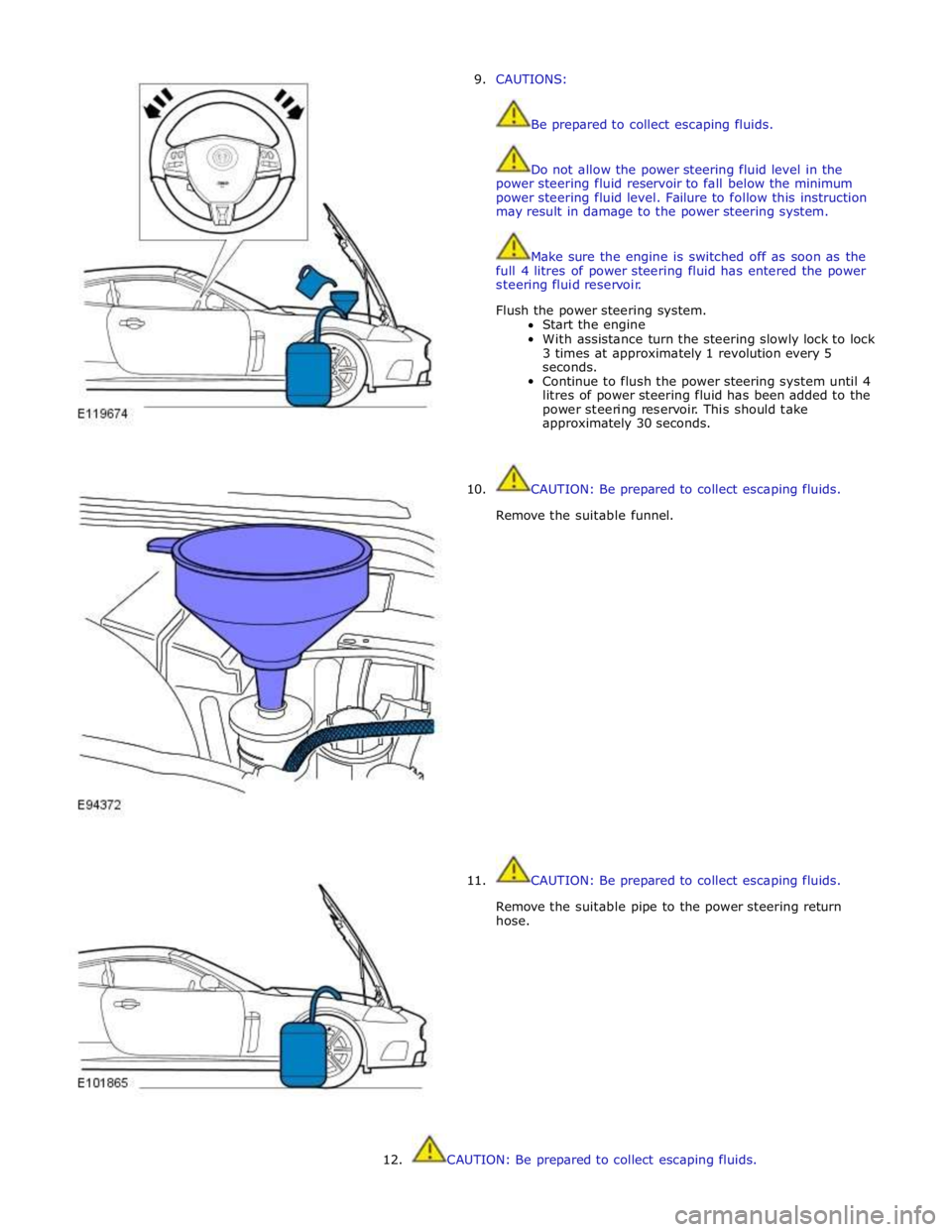
9. CAUTIONS:
Be prepared to collect escaping fluids.
Do not allow the power steering fluid level in the
power steering fluid reservoir to fall below the minimum
power steering fluid level. Failure to follow this instruction
may result in damage to the power steering system.
Make sure the engine is switched off as soon as the
full 4 litres of power steering fluid has entered the power
steering fluid reservoir.
Flush the power steering system.
Start the engine
With assistance turn the steering slowly lock to lock
3 times at approximately 1 revolution every 5
seconds.
Continue to flush the power steering system until 4
litres of power steering fluid has been added to the
power steering reservoir. This should take
approximately 30 seconds.
10.
11. CAUTION: Be prepared to collect escaping fluids.
Remove the suitable funnel.
CAUTION: Be prepared to collect escaping fluids.
Remove the suitable pipe to the power steering return
hose.
12.
CAUTION: Be prepared to collect escaping fluids.
Page 736 of 3039
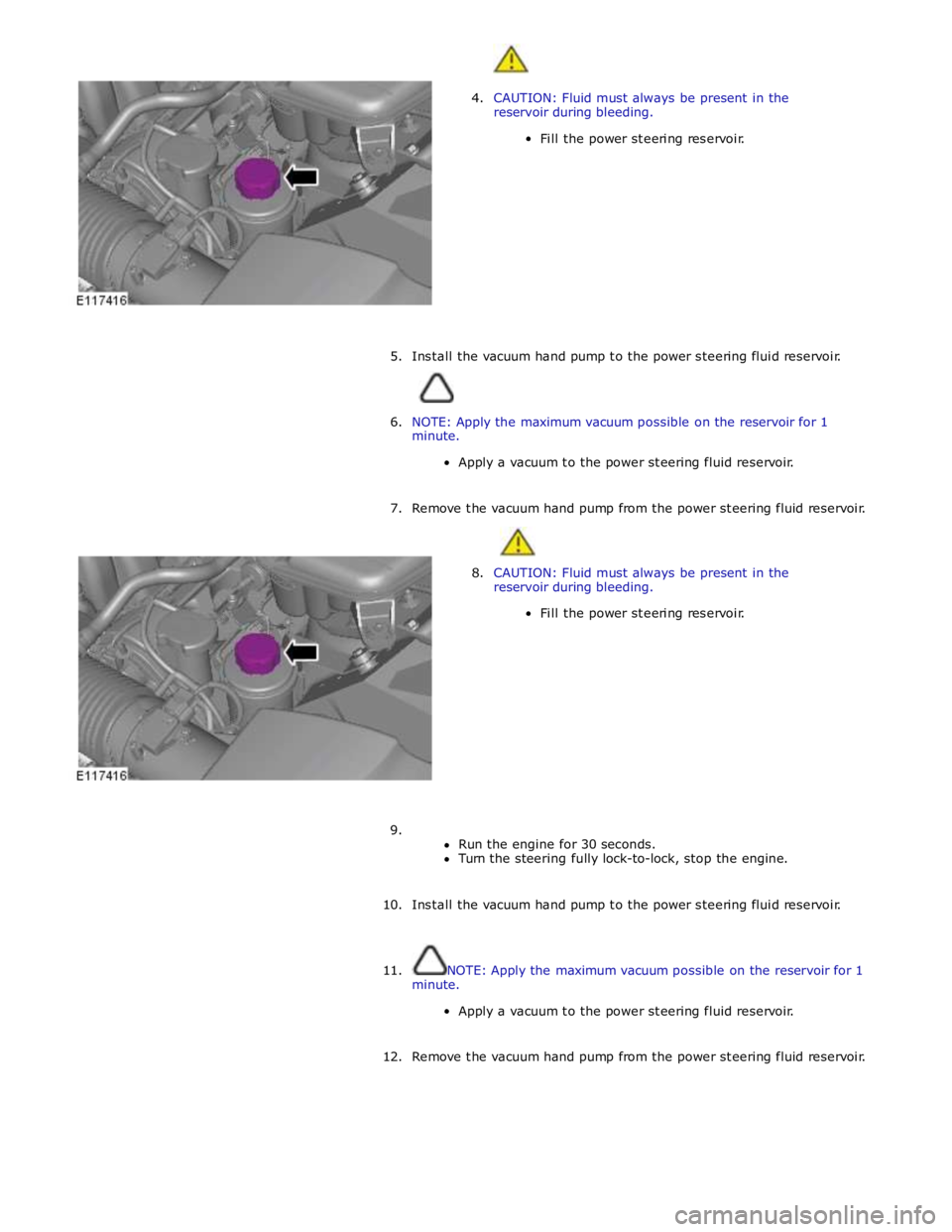
4. CAUTION: Fluid must always be present in the
reservoir during bleeding.
Fill the power steering reservoir.
5. Install the vacuum hand pump to the power steering fluid reservoir.
6. NOTE: Apply the maximum vacuum possible on the reservoir for 1
minute.
Apply a vacuum to the power steering fluid reservoir.
7. Remove the vacuum hand pump from the power steering fluid reservoir.
8. CAUTION: Fluid must always be present in the
reservoir during bleeding.
Fill the power steering reservoir.
9.
Run the engine for 30 seconds.
Turn the steering fully lock-to-lock, stop the engine.
10. Install the vacuum hand pump to the power steering fluid reservoir.
11. NOTE: Apply the maximum vacuum possible on the reservoir for 1
minute.
Apply a vacuum to the power steering fluid reservoir.
12. Remove the vacuum hand pump from the power steering fluid reservoir.
Page 737 of 3039
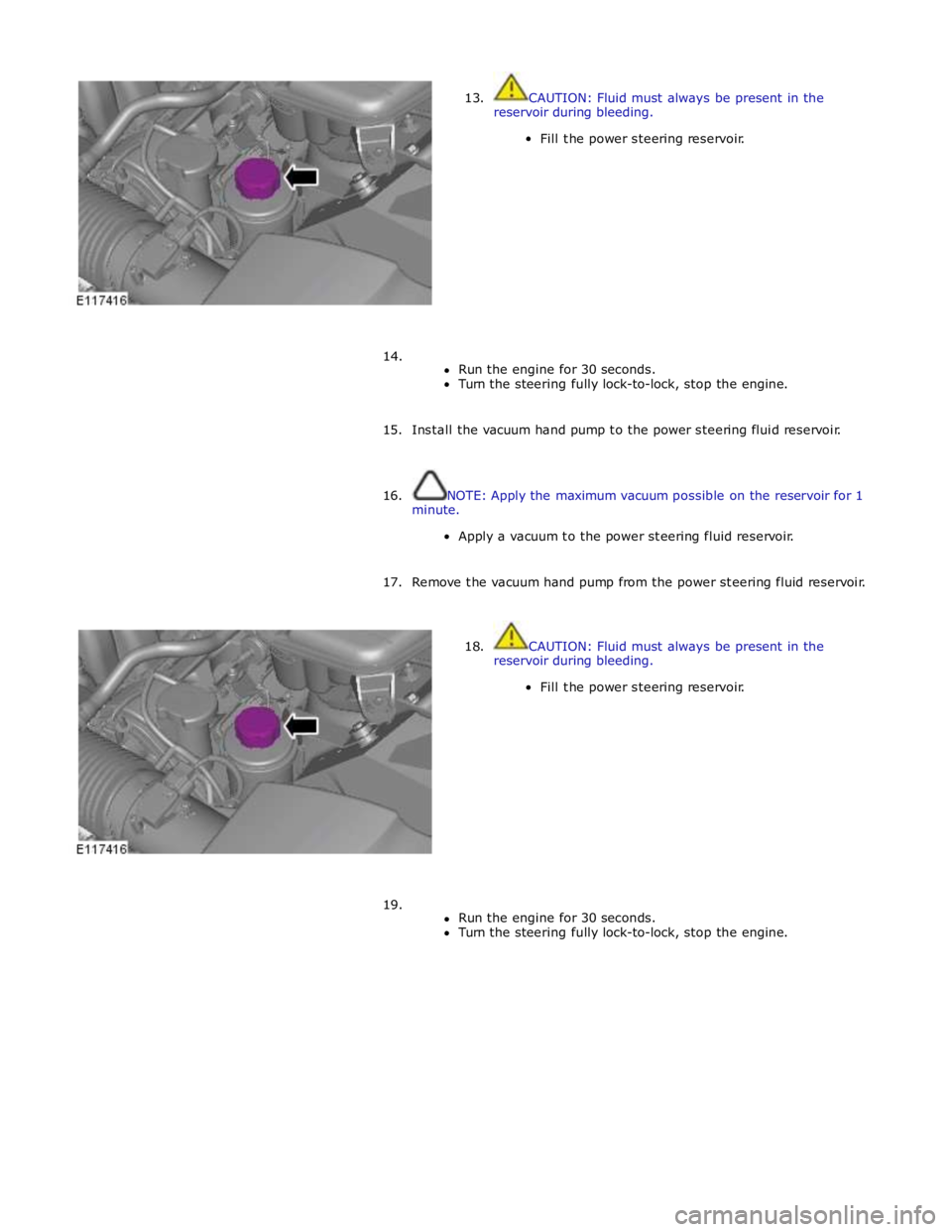
13. CAUTION: Fluid must always be present in the
reservoir during bleeding.
Fill the power steering reservoir.
14.
Run the engine for 30 seconds.
Turn the steering fully lock-to-lock, stop the engine.
15. Install the vacuum hand pump to the power steering fluid reservoir.
16. NOTE: Apply the maximum vacuum possible on the reservoir for 1
minute.
Apply a vacuum to the power steering fluid reservoir.
17. Remove the vacuum hand pump from the power steering fluid reservoir.
18. CAUTION: Fluid must always be present in the
reservoir during bleeding.
Fill the power steering reservoir.
19.
Run the engine for 30 seconds.
Turn the steering fully lock-to-lock, stop the engine.
Page 739 of 3039
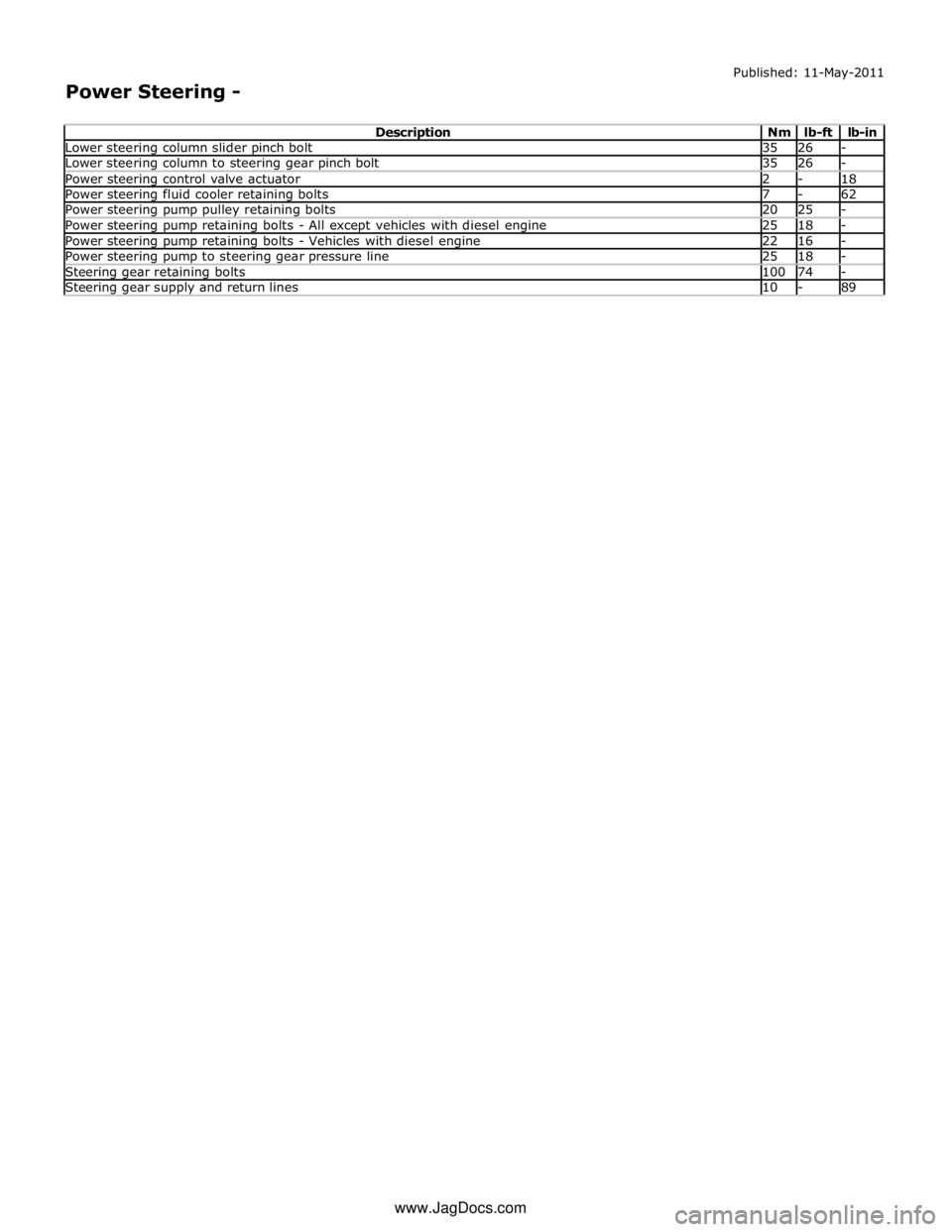
Lower steering column slider pinch bolt 35 26 - Lower steering column to steering gear pinch bolt 35 26 - Power steering control valve actuator 2 - 18 Power steering fluid cooler retaining bolts 7 - 62 Power steering pump pulley retaining bolts 20 25 - Power steering pump retaining bolts - All except vehicles with diesel engine 25 18 - Power steering pump retaining bolts - Vehicles with diesel engine 22 16 - Power steering pump to steering gear pressure line 25 18 - Steering gear retaining bolts 100 74 - Steering gear supply and return lines 10 - 89 www.JagDocs.com
Page 741 of 3039
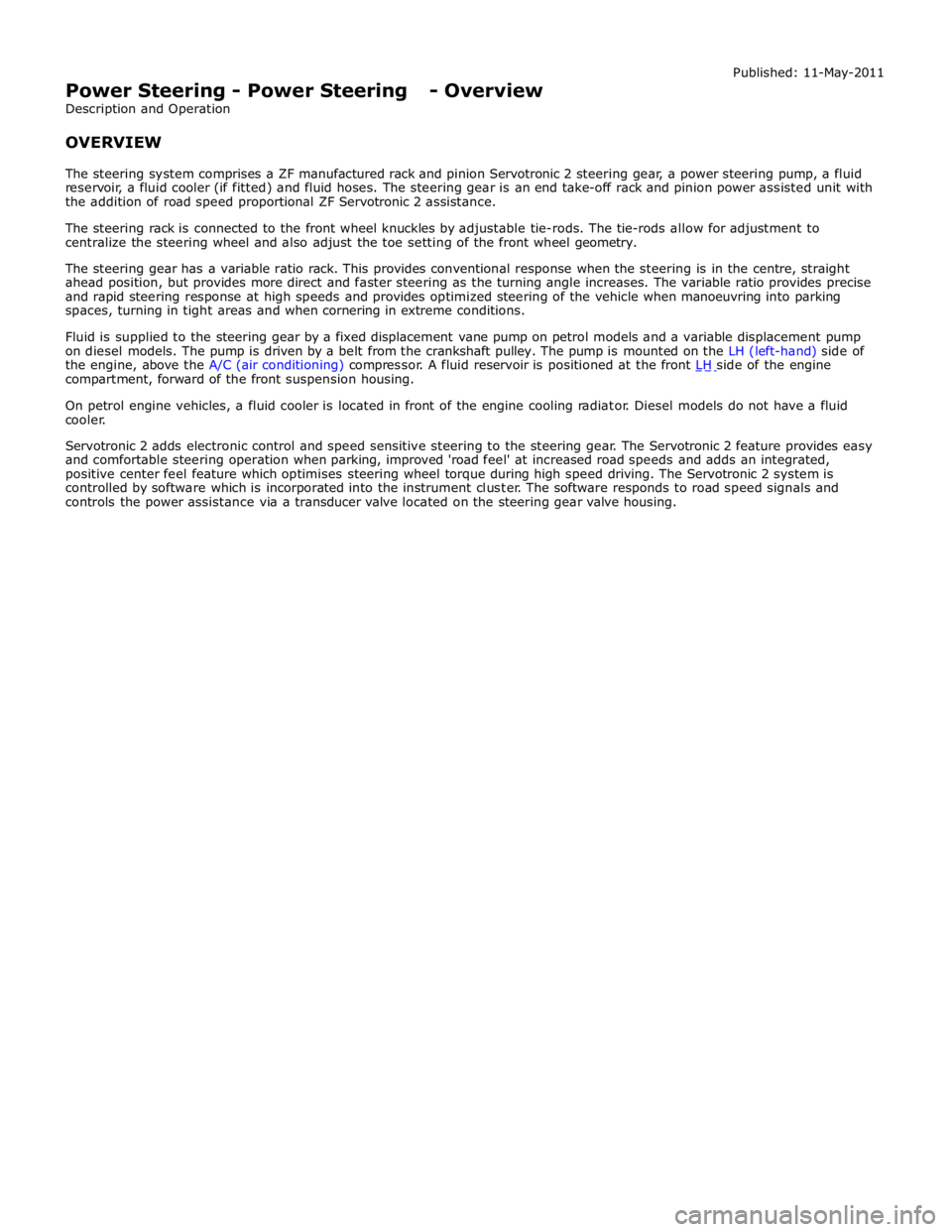
compartment, forward of the front suspension housing.
On petrol engine vehicles, a fluid cooler is located in front of the engine cooling radiator. Diesel models do not have a fluid
cooler.
Servotronic 2 adds electronic control and speed sensitive steering to the steering gear. The Servotronic 2 feature provides easy
and comfortable steering operation when parking, improved 'road feel' at increased road speeds and adds an integrated,
positive center feel feature which optimises steering wheel torque during high speed driving. The Servotronic 2 system is
controlled by software which is incorporated into the instrument cluster. The software responds to road speed signals and
controls the power assistance via a transducer valve located on the steering gear valve housing.
Page 743 of 3039
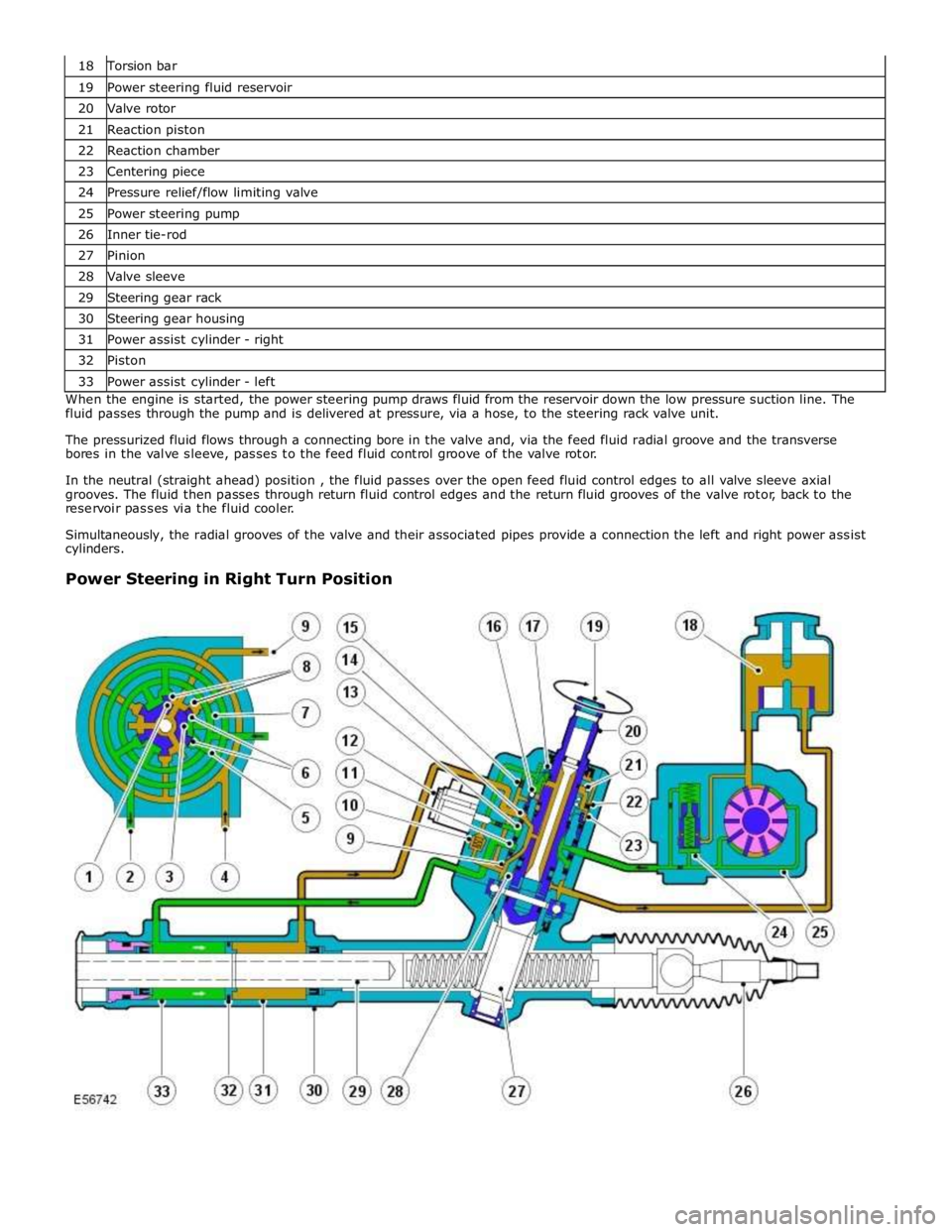
Torsion bar 19 Power steering fluid reservoir 20 Valve rotor 21 Reaction piston 22 Reaction chamber 23 Centering piece 24 Pressure relief/flow limiting valve 25 Power steering pump 26 Inner tie-rod 27 Pinion 28 Valve sleeve 29 Steering gear rack 30 Steering gear housing 31 Power assist cylinder - right 32 Piston 33 Power assist cylinder - left When the engine is started, the power steering pump draws fluid from the reservoir down the low pressure suction line. The
fluid passes through the pump and is delivered at pressure, via a hose, to the steering rack valve unit.
The pressurized fluid flows through a connecting bore in the valve and, via the feed fluid radial groove and the transverse
bores in the valve sleeve, passes to the feed fluid control groove of the valve rotor.
In the neutral (straight ahead) position , the fluid passes over the open feed fluid control edges to all valve sleeve axial
grooves. The fluid then passes through return fluid control edges and the return fluid grooves of the valve rotor, back to the
reservoir passes via the fluid cooler.
Simultaneously, the radial grooves of the valve and their associated pipes provide a connection the left and right power assist
cylinders.
Power Steering in Right Turn Position
Page 745 of 3039
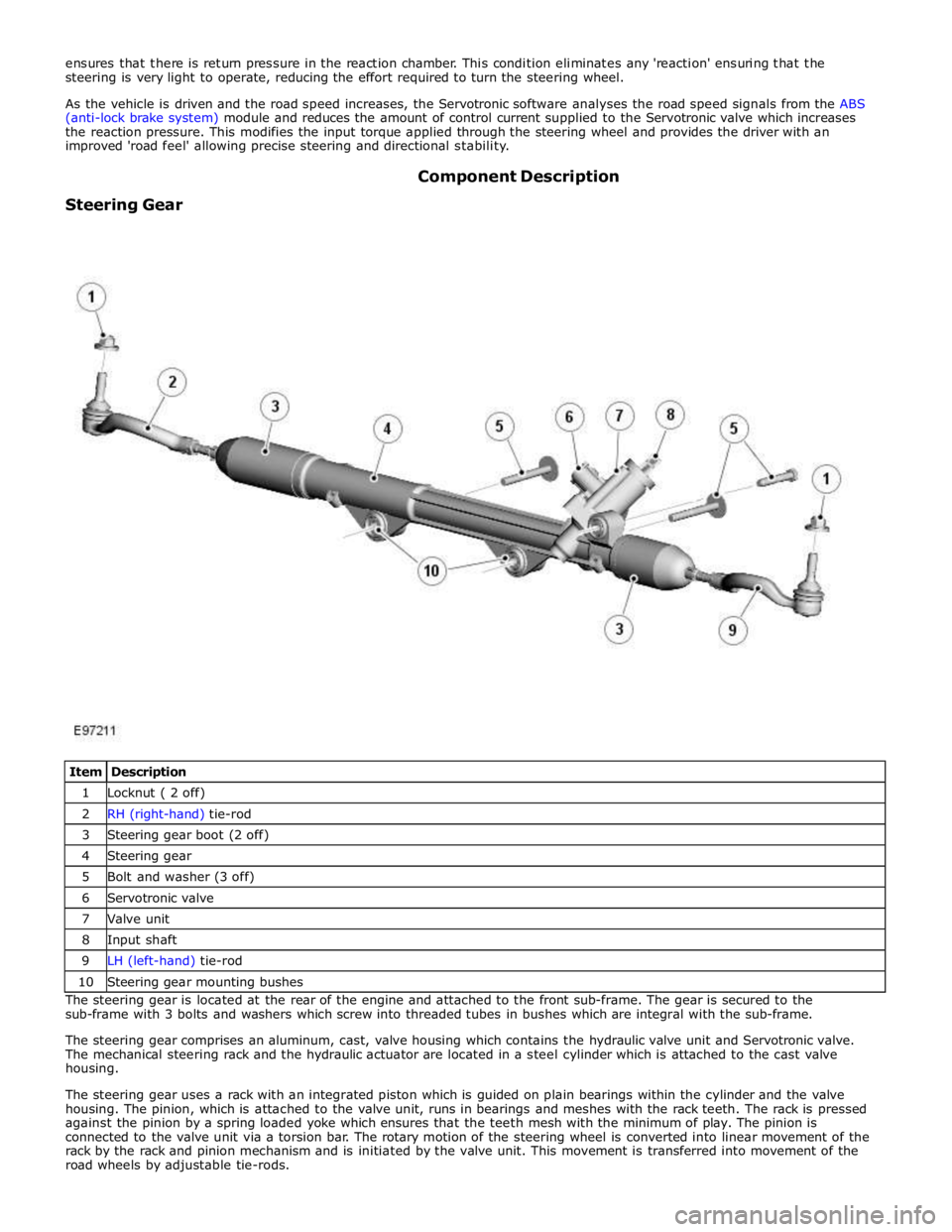
1 Locknut ( 2 off) 2 RH (right-hand) tie-rod 3 Steering gear boot (2 off) 4 Steering gear 5 Bolt and washer (3 off) 6 Servotronic valve 7 Valve unit 8 Input shaft 9 LH (left-hand) tie-rod 10 Steering gear mounting bushes The steering gear is located at the rear of the engine and attached to the front sub-frame. The gear is secured to the
sub-frame with 3 bolts and washers which screw into threaded tubes in bushes which are integral with the sub-frame.
The steering gear comprises an aluminum, cast, valve housing which contains the hydraulic valve unit and Servotronic valve.
The mechanical steering rack and the hydraulic actuator are located in a steel cylinder which is attached to the cast valve
housing.
The steering gear uses a rack with an integrated piston which is guided on plain bearings within the cylinder and the valve
housing. The pinion, which is attached to the valve unit, runs in bearings and meshes with the rack teeth. The rack is pressed
against the pinion by a spring loaded yoke which ensures that the teeth mesh with the minimum of play. The pinion is
connected to the valve unit via a torsion bar. The rotary motion of the steering wheel is converted into linear movement of the
rack by the rack and pinion mechanism and is initiated by the valve unit. This movement is transferred into movement of the
road wheels by adjustable tie-rods.
Page 749 of 3039
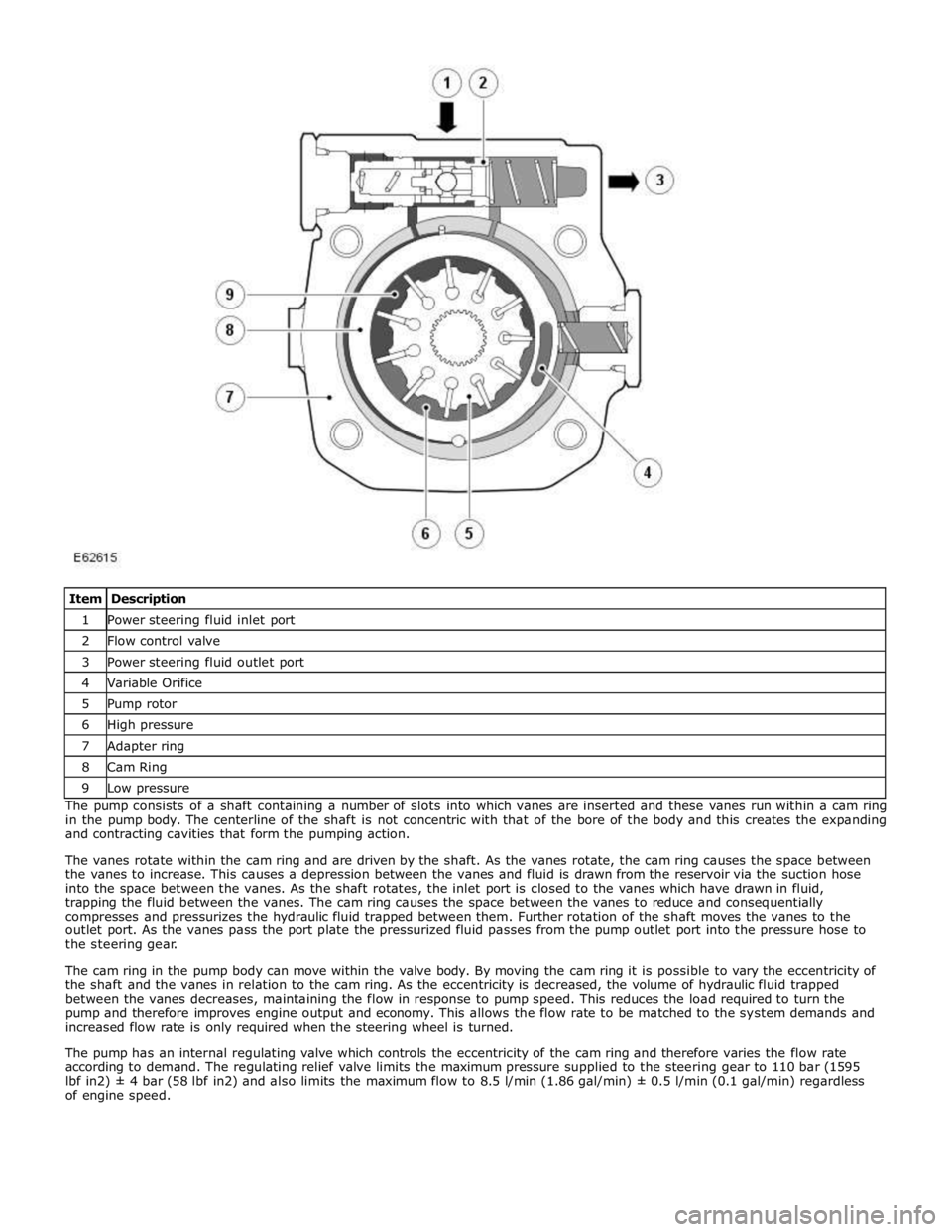
1 Power steering fluid inlet port 2 Flow control valve 3 Power steering fluid outlet port 4 Variable Orifice 5 Pump rotor 6 High pressure 7 Adapter ring 8 Cam Ring 9 Low pressure The pump consists of a shaft containing a number of slots into which vanes are inserted and these vanes run within a cam ring
in the pump body. The centerline of the shaft is not concentric with that of the bore of the body and this creates the expanding
and contracting cavities that form the pumping action.
The vanes rotate within the cam ring and are driven by the shaft. As the vanes rotate, the cam ring causes the space between
the vanes to increase. This causes a depression between the vanes and fluid is drawn from the reservoir via the suction hose
into the space between the vanes. As the shaft rotates, the inlet port is closed to the vanes which have drawn in fluid,
trapping the fluid between the vanes. The cam ring causes the space between the vanes to reduce and consequentially
compresses and pressurizes the hydraulic fluid trapped between them. Further rotation of the shaft moves the vanes to the
outlet port. As the vanes pass the port plate the pressurized fluid passes from the pump outlet port into the pressure hose to
the steering gear.
The cam ring in the pump body can move within the valve body. By moving the cam ring it is possible to vary the eccentricity of
the shaft and the vanes in relation to the cam ring. As the eccentricity is decreased, the volume of hydraulic fluid trapped
between the vanes decreases, maintaining the flow in response to pump speed. This reduces the load required to turn the
pump and therefore improves engine output and economy. This allows the flow rate to be matched to the system demands and
increased flow rate is only required when the steering wheel is turned.
The pump has an internal regulating valve which controls the eccentricity of the cam ring and therefore varies the flow rate
according to demand. The regulating relief valve limits the maximum pressure supplied to the steering gear to 110 bar (1595
lbf in2) ± 4 bar (58 lbf in2) and also limits the maximum flow to 8.5 l/min (1.86 gal/min) ± 0.5 l/min (0.1 gal/min) regardless
of engine speed.
Page 750 of 3039
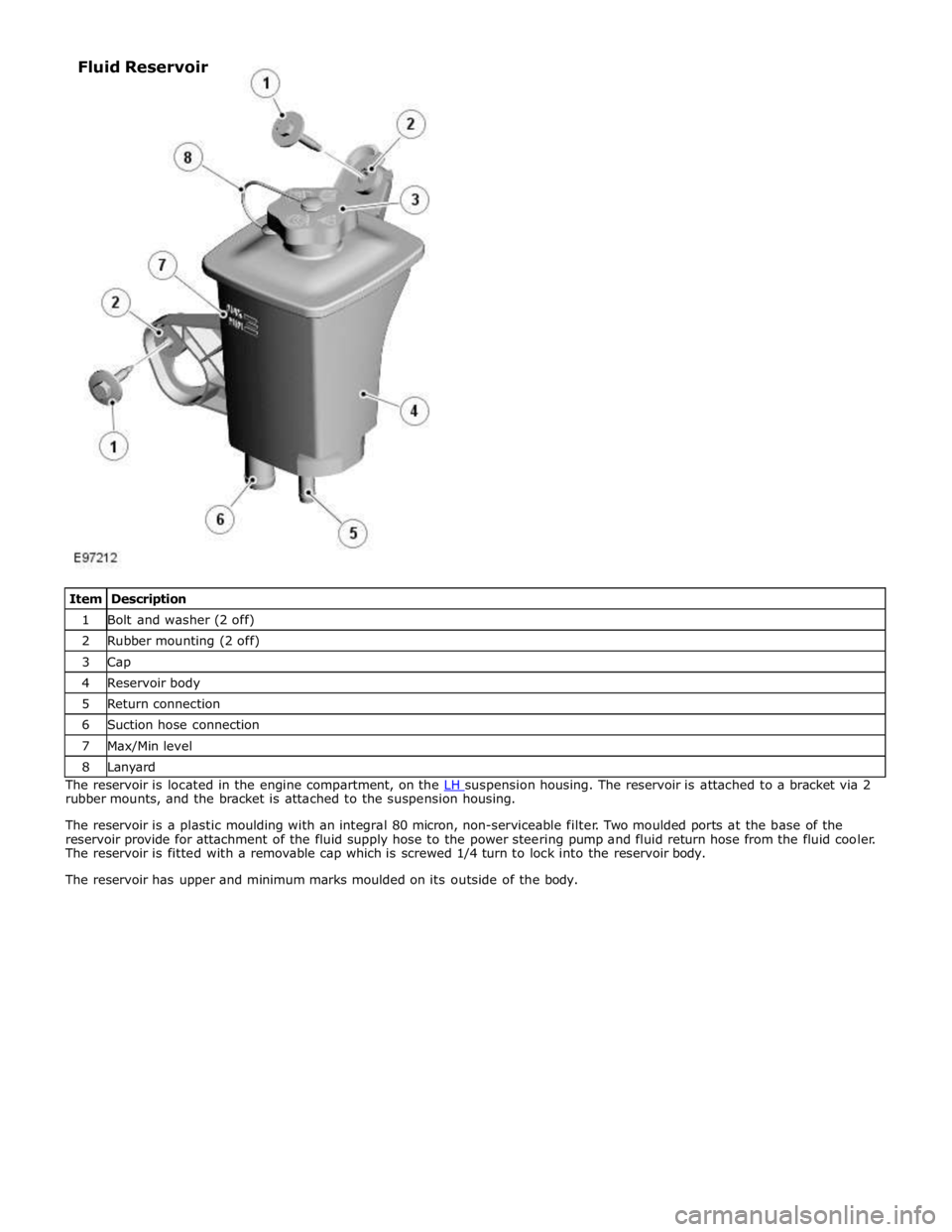
1 Bolt and washer (2 off) 2 Rubber mounting (2 off) 3 Cap 4 Reservoir body 5 Return connection 6 Suction hose connection 7 Max/Min level 8 Lanyard The reservoir is located in the engine compartment, on the LH suspension housing. The reservoir is attached to a bracket via 2 rubber mounts, and the bracket is attached to the suspension housing.
The reservoir is a plastic moulding with an integral 80 micron, non-serviceable filter. Two moulded ports at the base of the
reservoir provide for attachment of the fluid supply hose to the power steering pump and fluid return hose from the fluid cooler.
The reservoir is fitted with a removable cap which is screwed 1/4 turn to lock into the reservoir body.
The reservoir has upper and minimum marks moulded on its outside of the body. Fluid Reservoir